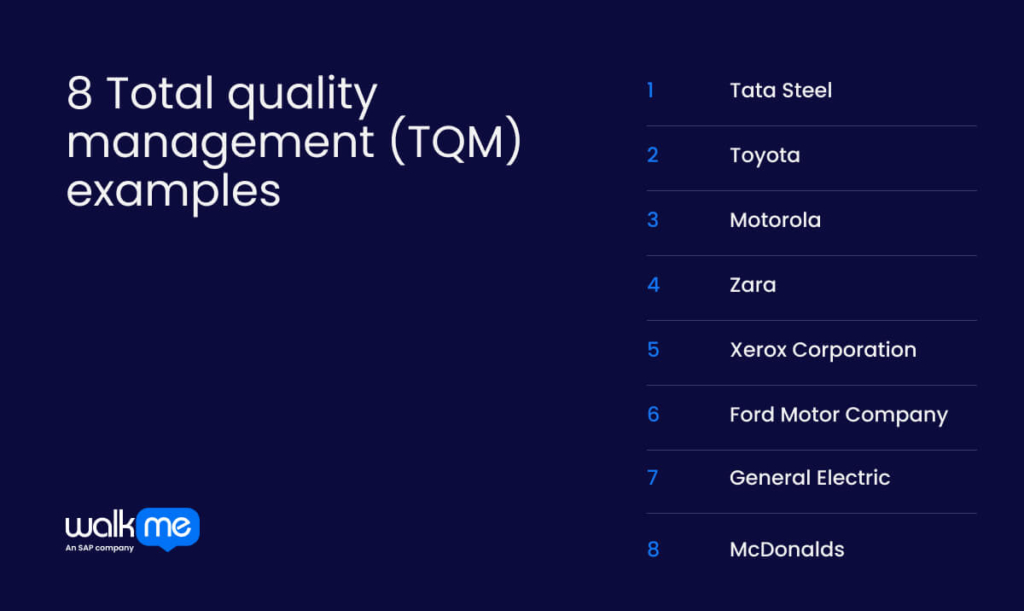Total quality management (TQM) is a process to find and fix errors continuously. It helps improve supply chains, customer service, and employee training. TQM focuses on raising the quality of goods and services by improving internal processes.
It ensures everyone involved in production takes responsibility for the final product’s quality. In short, TQM is a customer-focused approach that promotes ongoing improvement and aims to exceed customer expectations. In this article, we’ll explore 8 companies that successfully used TQM. These real-world examples show how they improved efficiency and effectiveness.

1. Tata Steel
To fix various problems with rules and the cost of steel, Tata Steel started a big change program in 2015 called ‘Shikhar25.’ The goal was to improve things, improve quality, and save money. They wanted to make $1 billion more in profit in three years. Tata Steel made sure workers were part of the changes.
The company encouraged big, risky ideas to get results. Managers used new tools and information to find and fix problems. They made sure the changes were easy to understand and do. They kept reports simple and focused on action, not long meetings.
Workers were trained to learn new skills so the company could handle future problems. The company set up special teams to manage the changes. These teams planned and worked on projects to improve things. They had weekly meetings to solve problems and track progress using simple pictures, not long presentations.
By 2018, ‘Shikhar25’ was even more successful than expected. It made $1.2 billion more in profit and improved cash flow. The program also created a culture of always improving, giving workers the skills to handle future changes and challenges.
2. Toyota
Originally, Toyota used a system called Kanban to make sure they only had what they needed to make cars. This system helped them make cars faster.
Toyota keeps only the parts needed to make cars for customers. This way, they don’t waste money on extra parts. They also keep a small amount of extra parts in case something goes wrong or they need more parts.
After a big earthquake in Japan in 2011, Toyota learned to keep more of certain important parts, like computer chips. They also learned that it’s important to get parts quickly.
Toyota also focuses on always learning and improving. Workers on the factory floor are encouraged to solve problems quickly. Leaders teach workers how to do this, which helps the whole system work better. Toyota also learns from its suppliers by helping them solve problems. This helps Toyota understand how to deal with future problems.
3. Motorola
In the early 2000s, Motorola had big problems. Its products had many defects, customers were unhappy, and the company lost market share. The biggest issue was with semiconductors, a key part of its products. These defects caused higher costs, wasted materials, and poor performance.
To fix this, Motorola used Six Sigma, a process they started in 1987 to improve quality. They followed the DMAIC method (Define, Measure, Analyze, Improve, Control). This helped them find the root causes of defects and make important changes. Quality improved, costs went down, and customers were more satisfied.
Motorola trained employees in Six Sigma to create a culture of constant improvement. At first, they faced challenges, like getting employees to support the changes and handling large amounts of data. But over time, they solved these problems and improved their approach.
Six Sigma helped Motorola turn things around. They became more competitive and profitable. This success shows how focusing on data and clear processes can solve tough problems. Many companies still use this method to improve quality and efficiency.
4. Zara
Zara has shown strong growth since 2013, except for 2020 due to COVID-19. Despite this setback, Zara’s performance highlights its strength in the competitive fashion market.
Founder Amancio Ortega wanted Zara to control its supply chain and be more flexible. He introduced just-in-time (JIT) production, where only what is needed is made at the right time. This reduces waste and keeps production efficient. As a result, Zara can maintain low inventories while constantly updating collections.
Zara uses a pull system for inventory. They only produce and send items based on customer orders. This prevents overproduction and ensures the right amount of product is always available.
Its agile supply chain is supported by technology. The company can design, produce, and distribute clothes quickly based on customer feedback and market trends. Zara uses advanced inventory management and analytics to track preferences and adjust production. The company also uses Kanban to manage inventory. This method helps Zara spot high-demand products and adjust production, improving efficiency and reducing excess inventory.
5. Xerox Corporation
In the 1980s, Xerox had trouble competing with Japanese companies that made cheaper and better copiers. To become better, Xerox used a system called total quality management (TQM).
TQM focuses on making customers happy, getting workers involved, and always improving. Xerox compared itself to the best companies to see how they could improve. They also trained workers to make things better and created teams to set and check standards. Leaders made quality a top priority for everyone, from making products to helping customers.
By the early 1990s, Xerox made things cheaper and had fewer mistakes. Customers were also happier. These efforts helped Xerox become a better company again and win awards.
Today, Xerox is still changing. They use employee resource groups to make things more efficient and work with other companies like SAP to modernize how they work. Xerox has moved to the cloud to save money and make things simpler. This helps Xerox create new ways to do business and meet customer needs.
6. Ford Motor Company
In the 1980s, Ford adopted total quality management (TQM) to address quality issues and improve its position in the global automotive market. As part of this effort, the company launched the ‘Quality is Job 1’ initiative, emphasizing a commitment to excellence in production and customer satisfaction.
Ford implemented a quality operating system (QOS), a structured approach to managing quality that focused on preventing defects rather than detecting them. The company worked closely with its suppliers to ensure the use of high-quality materials and components.
Since then, employees at all levels have been actively involved in quality improvement efforts, supported by extensive training programs. Ford invested heavily in Six Sigma training, creating various roles.
Each role had specific responsibilities. Project champions, typically senior leaders, supported initiatives and removed barriers. Master black belts mentored black belts and reported progress to leadership. Black belts led Six Sigma projects, while green belts contributed to smaller projects and brought specialized expertise.
The initiative delivered impressive results. Manufacturing defects and warranty claims were significantly reduced. Production efficiency improved, leading to cost savings. Additionally, Ford’s reputation and customer satisfaction increased, reinforcing the company’s commitment to quality.
7. General Electric
In the 1980s, GE’s boss, Jack Welch, started a program called ‘Work-Out’ to improve productivity. He wanted workers to question old rules and find new ways to work.
The program used ideas from making things faster and better to fix problems like too much paperwork and slow approvals. Leaders had to decide on new ideas right away. This made changes faster and helped the company change its way of thinking.
The program started at GE’s training center, where Welch talked to people and trained them. Managers shared their problems with old rules, so they created “Work-Out” to solve them together. They made things faster by getting rid of unnecessary rules and making things simpler. By the 1990s, ‘Work-Out’ was used with customers, suppliers, and teams around the world, becoming a big part of GE’s culture.
Today’s GE boss, Larry Culp, is building on these ideas with TQM and lean practices. Culp uses quick meetings to solve problems, improve how things are done, and reduce mistakes. He encourages managers to share problems and work together to fix them. This helped GE split into three companies, making them faster and ready for the future.
8. McDonalds
McDonald’s uses a mix of TQM and lean principles to improve efficiency and reduce waste. Through Kaizen, employees suggest small, ongoing improvements to processes. Just-in-time inventory minimizes storage costs and prevents food waste. The 5S system keeps workplaces organized, boosting employee productivity and efficiency.
To ensure consistent quality, McDonald’s uses tools like process mapping and Six Sigma’s DMAIC framework to reduce errors. Mistake-proofing techniques, or poka-yoke, prevent operational mistakes, ensuring reliable food quality.
Lean Six Sigma also helps lower costs. Root cause analysis identifies waste, while total productive maintenance keeps equipment running efficiently, reducing downtime and repair expenses. These measures streamline operations and cut unnecessary expenses.
Customer satisfaction is enhanced through time-motion studies to reduce wait times and the Kanban system to ensure fresh food availability. Critical to quality (CTQ) tools help translate customer needs into measurable service goals, ensuring fast and high-quality service.
Standardization ensures consistent experiences across global locations. Detailed procedures, training, and visual tools help employees maintain quality and speed. This uniformity strengthens the brand and builds trust.
By improving processes, cutting costs, and focusing on quality, McDonald’s remains a leader in the fast-food industry. Its commitment to lean principles ensures efficiency, reliability, and global success.
Use these TQM examples to lower costs and improve quality for your business
Total quality management (TQM) helps companies make things better. It focuses on making customers happy and making the company work better. In today’s world with computers, TQM is even more important. Computers help companies make things better and faster, which helps them stay ahead of the competition.
To use TQM like successful companies, first, understand your company’s goals and how it works. Then, make a plan to improve things. Figure out what your customers want and how you can give it to them. Get a team of workers and managers to help you put the plan into action. Keep asking workers and customers for feedback to see how you’re doing and make things even better.

FAQs
Total quality management (TQM) is focused on improving quality in all parts of the company, while quality management only looks at enhancing product and service quality.
The main principles of total quality management (TQM) are employee involvement, customer focus, process approach, fact-based decision-making, communication, continuous improvement, leadership commitment, and system integration.

